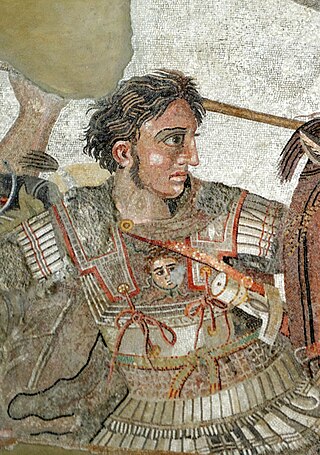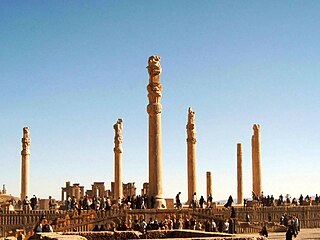
Xerxes I, called Xerxes the Great, was the fifth king of kings of the Achaemenid dynasty of Persia. Like his father and predecessor Darius I, he ruled the empire at its territorial apex. He ruled from 486 BC until his assassination in 465 BC at the hands of Artabanus, the commander of the royal bodyguard.

Darius I, commonly known as Darius the Great, was the fourth Persian King of Kings of the Achaemenid Empire. He ruled the empire at its peak, when it included much of West Asia, the Caucasus, parts of the Balkans, most of the Black Sea coastal regions, parts of the North Caucasus, Central Asia, as far as the Indus Valley in the far east and portions of north and northeast Africa including Egypt (Mudrâya), eastern Libya, and coastal Sudan.

Darius III, originally named Artashata and called Codomannus by the Greeks, was the last king of the Achaemenid Empire of Persia, from 336 BC to 330 BC. Artashata adopted Darius as a dynastic name.

Persepolis was the ceremonial capital of the Achaemenid Empire. It is situated 60 km northeast of the city of Shiraz in Fars Province, Iran. The earliest remains of Persepolis date back to 515 BC. It exemplifies the Achaemenid style of architecture. UNESCO declared the ruins of Persepolis a World Heritage Site in 1979.

A court is an extended royal household in a monarchy, including all those who regularly attend on a monarch, or another central figure. Hence the word court may also be applied to the coterie of a senior member of the nobility.

Ochus, better known by his dynastic name of Artaxerxes III was King of Kings of the Achaemenid Empire from 358 to 338 BC. He was the son and successor of Artaxerxes II and his mother was Stateira.

The wars of Alexander the Great were fought by King Alexander III of Macedon, first against the Achaemenid Persian Empire under Darius III, and then against local chieftains and warlords as far east as Punjab, India. By the time of his death, he had conquered most of the world known to the ancient Greeks. However, he failed to conquer South Asia. Although being successful as a military commander, he failed to provide any stable alternative to the Achaemenid Empire—his untimely death threw the vast territories he conquered into civil war.

Thaïs was a famous Greek hetaera who accompanied Alexander the Great on his campaigns. She is most famous for instigating the burning of Persepolis. At the time, Thaïs was the lover of Ptolemy I Soter, one of Alexander's generals. It has been suggested that she may also have been Alexander's lover, on the basis of Athenaeus's statement that Alexander liked to "keep Thaïs with him", but this may simply mean he enjoyed her company. She is said to have been very witty and entertaining. Athenaeus also says that after Alexander's death Ptolemy married Thaïs, who bore three of his children.

Pasargadae was the capital of the Achaemenid Empire under Cyrus the Great, who ordered its construction. Today it is an archaeological site and one of Iran's UNESCO World Heritage Sites, about 90 km to the northeast of the modern city of Shiraz. A limestone tomb there is believed to be that of Cyrus the Great.

Persis, better known as Persia, or Persia proper, is a region located to the southwest of modern Iran. The Persians are thought to have initially migrated either from Central Asia or, more probably, from the north through the Caucasus. They would then have migrated to the current region of Persis in the early 1st millennium BC. The country name Persia was derived directly from the Old Persian Parsa.

Persian columns or Persepolitan columns are the distinctive form of column developed in the Achaemenid architecture of ancient Persia, probably beginning shortly before 500 BCE. They are mainly known from Persepolis, where the massive main columns have a base, fluted shaft, and a double-animal capital, most with bulls. Achaemenid palaces had enormous hypostyle halls called apadana, which were supported inside by several rows of columns. The Throne Hall or "Hall of a Hundred Columns" at Persepolis, measuring 70 x 70 metres was built by the Achaemenid king Artaxerxes I. The Apadana hall is even larger. These often included a throne for the king and were used for grand ceremonial assemblies; the largest at Persepolis and Susa could fit ten thousand people at a time.

Apadana is a large hypostyle hall, best said the great audience hall and portico at Persepolis and the palace of Susa. The Persepolis Apadana belongs to the oldest building phase of the city of Persepolis, the first half of the 6th century BC, as part of the original design by Darius the Great. Its construction completed by Xerxes I. Modern scholarships "demonstrates the metaphorical nature of the Apadana reliefs as idealised social orders".

Ariobarzanes, also spelled as Ario Barzan or Aryo Barzan and commonly known as Ariobarzanes the Brave, was an Achaemenid prince, satrap and a Persian military commander who led a last stand of the Persian army at the Battle of the Persian Gate against Macedonian King Alexander the Great in the winter of 330 BC.

The Battle of the Persian Gate was a military conflict between a Persian force, commanded by the satrap of Persis, Ariobarzanes, and the invading Hellenic League, commanded by Alexander the Great. In the winter of 330 BC, Ariobarzanes led a last stand of the outnumbered Iranian forces at the Persian Gates near Persepolis, holding the Macedonian army for a month. Alexander eventually found a path to the rear of the Iranians from the captured prisoners of war or a local shepherd, eventually capturing Persepolis.

Athura, also called Assyria, was a geographical area within the Achaemenid Empire in Upper Mesopotamia from 539 to 330 BC as a military protectorate state. Although sometimes regarded as a satrapy, Achaemenid royal inscriptions list it as a dahyu, a concept generally interpreted as meaning either a group of people or both a country and its people, without any administrative implication.

Achaemenid architecture includes all architectural achievements of the Achaemenid Persians manifesting in construction of spectacular cities used for governance and inhabitation, temples made for worship and social gatherings, and mausoleums erected in honor of fallen kings. The quintessential feature of Persian architecture was its eclectic nature with elements of Assyrian, Egyptian, Median and Asiatic Greek all incorporated, yet producing a unique Persian identity seen in the finished product. Achaemenid architecture is academically classified under Persian architecture in terms of its style and design.

The Achaemenid Empire, also called the First Persian Empire, was an ancient Iranian empire based in Western Asia founded by Cyrus the Great. Ranging at its greatest extent from the Balkans and Eastern Europe proper in the west to the Indus Valley in the east, it was larger than any previous empire in history, spanning 5.5 million square kilometers. Incorporating various peoples of different origins and faiths, it is notable for its successful model of a centralised, bureaucratic administration, for building infrastructure such as road systems and a postal system, the use of an official language across its territories, and the development of civil services and a large professional army. The empire's successes inspired similar systems in later empires.

The Tachara, or the Tachar Château, also referred to as the Palace of Darius the Great, was the exclusive building of Darius I at Persepolis, Iran. It is located 70 km northeast of the modern city of Shiraz in Fars Province.

Shahrokh Razmjou is an Iranian archaeologist and historian, specializing in Achaemenid Archaeology and History. He received his Ph.D in Achaemenid Archaeology at the University of London. He established the Inscriptions Hall (1998-9) and the Centre for Achaemenid Studies (2001) at the National Museum of Iran. He was curator of Ancient Iran in the Department of the Middle East, British Museum (2009-2012) and during this time, he produced a new updated translation of the text on the Cyrus Cylinder from Babylonian to Persian. He also excavated the ancient man-made caves of Niyasar, Kashan. He is currently teaching at the Department of Archaeology, University of Tehran.

The Palace of Darius in Susa was a palace complex in Susa, Iran, a capital of the Achaemenid Empire. The construction was conducted parallel to that of Persepolis. Man-power and raw materials from various parts of the empire contributed to its construction. It was once destroyed by fire and was partially restored later. Little has remained from this important complex.



















